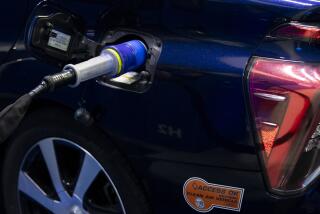Fuel-Cell Vehicles May Need a Big Push to Get Rolling
Fuel-cell vehicles--celebrated by proponents as the answer to California’s demand for zero-emission cars and trucks--will get here someday, but not without a tremendous public and political effort, according to a new report prepared for the independent California Fuel Cell Partnership.
The state has mandated that 10% of passenger vehicles sold here by the leading auto manufacturers qualify as zero-emission and nearly nonpolluting vehicles by the end of the 2003 model year. True zero-emission vehicles powered by batteries or fuel cells must account for at least 2% of the mix, augmented by hybrid gasoline-electric vehicles, extremely clean gasoline models and others to meet the 10% requirement.
Fuel cells use hydrogen to produce current that can be used to propel electric cars and trucks. Because the electricity is produced on board, a fuel-cell vehicle’s range is not limited by the need for lengthy sessions plugged into a recharging station.
For now, though, that promise is restrained by many stumbling blocks to wide application of the technology. The biggest, the report found, will be the huge cost to develop the essential hydrogen fuel supply--a cost private industry is unlikely to shoulder without massive subsidies.
The study team, which released its findings Tuesday, determined that in California alone, cumulative losses from operating and supplying just 500 hydrogen stations--equal to about 5% of the gas stations in the state--could hit $235 million before there are enough of the vehicles in use for fuel sales to begin earning profit. It could take a decade of sustained losses and several more years of break-even financing before that first profit will materialize.
The industry would need substantial government assistance--tax breaks, grants and other subsidies--to make it out of the development stage and into mass production and retailing of fuel-cell vehicles, said Robert Knight, the Hayward, Calif.-based consultant who led the study team.
“They are an exciting innovation, different from anything in the past
The fuels report is the first intensive evaluation of the four fuels considered most practical for fuel-cell vehicles: pure hydrogen and three feedstocks from which hydrogen can be extracted--ethanol, methanol and a sulfur-free gasoline called clean hydrocarbon fuel.
Knight’s team was asked to identify challenges and solutions to bringing each to market, but because of the makeup of the fuel-cell partnership--whose members include competing vehicle developers and fuel providers--was barred from recommending one over the others.
The 187-page study (online at https://www.fuelcellpartnership.org ) found no problems that could not be solved if society is willing to throw enough money at them--certainly no insurmountable technical obstacles.
And though studiously evenhanded in its evaluation of the four fuels, the study seems to point to pure hydrogen as most likely to be used in the early stages of commercializing fuel-cell vehicles.
For one thing, it is the only fuel that enables fuel-cell vehicles to meet the California Air Resources Board’s definition of a zero-emission vehicle. Fuel cells produce electricity from the interaction of hydrogen and oxygen passed over a catalyst. In an automotive application, the current generated is used to power an electric motor that propels the vehicle. By producing electricity on board the vehicle, fuel cells eliminate the need for storage batteries, which add tremendous weight and must be regularly recharged.
The electrochemical reaction is pollution-free--the only emissions are heat and a slight amount of distilled water. So if hydrogen is pumped directly into a vehicle’s fuel tank and then run through the fuel cell, the result is a zero-emission car or truck.
But production of hydrogen--especially if drawn from hydrocarbon fuels, or feedstocks, such as gasoline, natural gas or ethanol--still results in toxic and smog-causing emissions, albeit at much lower levels than from present-day internal-combustion engines or stationary power plants.
Fuel-cell developers today are proceeding with two warring approaches: reformer systems and direct-hydrogen systems.
The first type produce hydrogen on board the vehicle through a small but complex hydrocarbon reformer, essentially a miniature chemical plant. They would eliminate the huge cost of developing a hydrogen production and delivery infrastructure but add the expense of a reformer to each vehicle.
Direct-hydrogen systems use liquid or gaseous hydrogen produced in stationary facilities and sent to fueling stations, much as gasoline is produced at refineries and delivered to service stations. They would eliminate the cost and technical difficulties of perfecting and installing reformers on fuel-cell vehicles but add the cost of the hydrogen infrastructure.
Total costs would be about the same, the report shows, but the direct-hydrogen approach would require most financial support up front while reformer systems would spread the costs out.
And even once the fuel equation is solved, rolling out fuel-cell vehicles for public consumption would require massive retrofitting of the nation’s service stations to handle hydrogen or hydrogen feedstocks. Additionally, mechanics would have to be retrained to service fuel-cell vehicles, garages would have to be re-equipped and the public would have to be persuaded that hydrogen is not a particularly dangerous fuel.
But development of a hydrogen fuel program to reduce national dependence on oil and to promote zero-emission vehicles “could take on a higher priority” in coming years, Knight said.
*
Times staff writer John O’Dell covers autos for Highway 1 and the Business section. He can be reached at [email protected].
More to Read
Inside the business of entertainment
The Wide Shot brings you news, analysis and insights on everything from streaming wars to production — and what it all means for the future.
You may occasionally receive promotional content from the Los Angeles Times.










